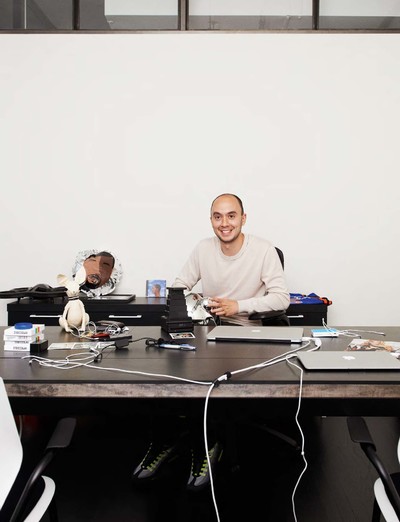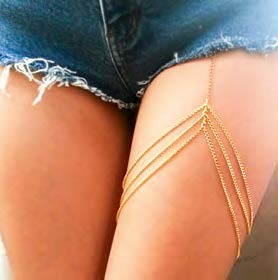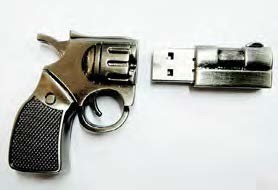Why everyone from François Henri-Pinault to Will Smith has invested in Joe Einhorn’s digital retail concept, Fancy.
By Jonathan Wingfield
Portrait by Jason Schmidt
Why everyone from François Henri-Pinault to Will Smith has invested in Joe Einhorn’s digital retail concept, Fancy.

Here’s a challenge. Try, just try, to visit fancy.com without buying anything. Or at least being seriously temped to par- take with the digits on your credit card. Maybe those classic penny loafers from Saint Laurent. Or a night at the Four Seasons Shanghai. Or perhaps those replica Daft Punk helmets you’ve always secretly had eyes for. Fancy, seemingly, has it all.
In the world of e-commerce, Fancy isn’t nearly as fashion friendly as Net- a-Porter or Yoox and maintains only a fraction of the product range of Amazon. But what it has is a global community of 10 million users who, like Fancy’s founder Joe Einhorn, enjoy hunting, sharing and purchasing what Einhorn lovingly refers to as ‘cool stuff’.
Fancy in itself is nothing. It’s like an empty Colette – a building without the Raf Simons jackets, the tech gadgets and the Japanese skateboard decks. But it’s this bare platform that allows Fancy’s users to show off their curatorial prowess, sourcing an eclectic array of products that then get voted on – or, to use the correct terminology, ‘Fancy’d’. Items that get Fancy’d trigger greater user interest. Greater user interest equals sales. Fancy generates sales transactions in the region of $200,000 every day. That’s $73 million a year.
On one level, Fancy comes across a little bit ‘wannabe fashion buyer’. In the same way that the fashion industry still questions the merits of many self-proclaimed ‘style bloggers’, so it’ll probably have something to say about Fancy’s basic concept that we can all be a Colette or Barneys or Opening Ceremony buy- er. These are, after all, valued roles in the industry that require an expert’s experience and point of view. And anyone with an iPad can’t expect that a wi-fi connection alone will enable them to compete.
But then you discover that Fancy’s faithful users include luxury group Kering’s CEO François-Henri Pinault [fancy.com/fhp] and his ‘stock’ of enviable product suggestions from the likes of Saint Laurent, Gucci, Bottega Veneta and Puma. And then there’s the remarkable list of individuals and companies queuing up to invest in what they see as the future of the online retail experience: to date, the aforementioned Pinault, American Express, Will Smith, Facebook co-founder Chris Hughes, and Twitter founder Jack Dorsey. AmEx president Ed Gilligan calls Joe Einhorn ‘a visionary, laser-focused on building something meaningful.’ He goes on to describe Fancy as ‘an entirely new consumer experience that represents the intersection of community and commerce.’
It’s safe to say that Fancy isn’t sim- ply a Myspace-esque passing trend. Its user-generated inventory reflects how and society wants to consume, and the simple but sophisticated graphic tem- plate makes Amazon and eBay look like old dinosaurs. With the luxury fashion industry now firmly integrated into the Fancy experience, it would be foolish to ignore its growing influence on retail, distribution and even product range.
System met up with Joe Einhorn in his Manhattan office to discuss the online phenomenon that was born out of its founder’s love of collecting North Face jackets.
‘I never thought about wanting to be a businessman. I just wanted the dopest clothes and all the trappings.’
Jonathan Wingfield: Would you consider yourself a master of computers?
Joe Einhorn: Yes.
If I had a problem with my computer, would you know what to do?
Yeah, but I wouldn’t try to fix it. I’d probably just advise you to get a new one. Unless you had dropped the computer before I came in and you didn’t tell me, I’d take a few minutes to figure out that’s what you did. But other than that it’s pretty basic how they work.
Can you remember the first computer that you had?
My dad passed away more than ten years ago, but he was a big gadget guy. When we were young, he was into cameras because they were the big gadget at the time. Then when computers hit the scene, he was crazy about them too, and got us our first computer. It was called a Micron 286.
That was mid-1980s, right?
It was 1986. By the age of ten in 1991, I was on the computer and the internet. I remember how excited my dad was about Windows and the graphic user interfaces of both Apple and Microsoft.
Can you remember the first time you heard about the internet?
I had heard of the internet way back; I was using the internet chatting protocol called Internet Relay Chat or IRC. That was when I was 10, 11, or 12. I probably heard about it from my mom or my dad. But I remember using the internet to get the first proper job that I had. My mom was taking an adult education programme at a college, and she had an account for her college website where there were job postings for that small community. I was able to use her credentials to find my first work – that was when I was 16.

Were you always computer literate?
For my first job interview, I made an illustration using Photoshop and Quark Xpress. It designed my name – ‘Joey’ – and put a wave through it. I put that image on a webpage that I’d created for myself. I was 16 and went into this job interview and said, ‘Not only do I know about computer programming, but I also know about websites and graphic design.’ I showed them this basic design, and they were totally blown away!
What about your first online purchase?
I used to go on eBay, which has been around since 1995. I’d look at these items that I coveted. I couldn’t afford them, but I’d click around to see who else was bidding on them. You were able to eBay-message each other. Right from the beginning of eBay, I was meeting people online who shared these similar interests about the products I loved.
So, rather than connecting to people through music or sport chat rooms, it was all done on eBay.
As a kid I was crazy about collecting trading cards: sports stars, then Marvel cards – just buying, selling and trading. That interest evolved into a fashion interest because there was a big movement in New York City about collecting, buying, selling and trading certain types of Ralph Lauren, Polo and North Face designs. And sneakers, too.
‘Older guys used chat rooms to meet girls; this was more about buying, collecting and trading Ralph Lauren or North Face.’
So you’d discuss limited edition Polo shirts online?
You’d be bumping into people out and about on the streets of New York, or you’d work with people who shared those tastes, so it made total sense to gravitate towards those people on eBay as we all tried to find the coolest stuff. Older guys used chat rooms to meet girls; this was more about friendships – and buying, collecting and trading.
At what point did this online community grow beyond New York, or even internationally. Did you immediately see the scale potential?
The trend was really local. I grew up in the Lower East Side of Manhattan, and the first thing was meeting people from Brooklyn because that’s where the movement started. And then meeting people in Manhattan who weren’t that far away, but who I didn’t know. And then these other boroughs like Queens… I watched it spread to other states. Now it’s obviously international and sophisticated, but back then it made no difference if you were from Brooklyn, Queens or Japan. It was all totally foreign to me.

Growing up, I naively had this idea that all American kids of my generation dreamt of becoming a sportsman, a musician – probably a rapper – or a businessman. Which of those three, if any, did you want to be?
All three. I used to play sports and basketball in the park everyday until I started to work. Mainstream rap really happened when I was a kid, but it wasn’t about wanting to be a rapper as much as it was everyone talking about the same thing – wanting to get money! I never thought of wanting to be a businessman; I was thinking about wanting to have the dopest clothes and all the trappings.
So basketball was the sport?
…and Michael Jordan was the sportsman. And Nas was the rapper. It’s a great pleasure for me now that I get to work with Nas at my company because he’s someone I’ve got to become friendly with – it’s terrific. I never really wanted to be a businessperson, though. In my elementary school yearbook, I said I wanted to be a cartoonist or an artist.
Do you consider what you’re doing at Fancy to be a creative endeavour?
For me, the internet is a new creative medium, it’s very interactive. Way cooler than making cartoons for me is making killer websites and applications. If you look at this company, and look at what my interests were as I was growing up, it’s fair to say this is the adult representation of those interests.
I know cool artists – and I love them – but for me it’s like, ‘make an app!’ If you think about Google, they’re taking art to a place way beyond what any artist imagined you could go. [Picks up a black pyramid-tiered object] You know what this is?
What is that?
It takes your iPhone photos and converts them into Polaroids! For me, this holds its own against any other fine art. It costs $300, it’s limited edition, it’s fucking handmade. Our whole thing boils down to this here: it’s high tech, it’s low tech, it’s limited edition, it’s handmade, it’s affordable, and we sell them around the world. All I ever wanted to do was to be artistic in a way that resonated with people who had similar interests with me.
Fancy is the convergence of commerce and community. What about social networking? Are you a big Facebook user?
I never really took to Facebook. I don’t like the idea of keeping track of people who I already know. Facebook is a $100 billion company: a few people get rich off of everybody’s contacts or photos from their computer. Whereas at our thing, it’s a marketplace where people can buy and sell stuff, and hopefully people’s products look good on our system and that’s helping their branding and marketing and hopefully driving sales and engaging demand. To me, that makes more sense.
‘Making killer websites is way cooler than making art. Google are taking art to a place way beyond what any artist ever imagined you could go.’
How does one come up with a smart digital solution such as Fancy? Is it by knowing everything that’s going on in technology? Or is it by understanding what’s happening in the world?
In my case, I’m not a very smart person. I’m always the dumbest guy in the room. I’m not saying that to be self-deprecating, it’s just the truth. What happened with computers and the internet is that I was lucky enough to be there from the beginning. When they arrived, everything was so basic that even I could operate a computer to its limit. And then you’d have to wait until there was some innovation – new computer, new chipset, new functionality – and then you’d adapt to that. My entry level into computers and the internet was when they were aligned with my understanding of the world. And as they became more sophisticated, I went along for the ride.

And you’ve always kept up.
Well, technology is like the fashion and media worlds that you operate in: you see the same shit over and over again. Technology is the exact same: there’s no huge secrets, it’s all the same shit, just a little faster or prettier. What’s the iPhone? It’s an mp3 player mixed in with a cell phone that doesn’t even work and some paired-down apps. I had the curiosity to follow these things when I was younger; not the intelligence, just the endurance and time spent with these machines.
Do you think it’s strange that relatively young and inexperienced people are now ruling the world?
You said it: some of these guys have never had a job before, but now they’re the most important business people in the world. Why? Because they made a product that people liked, on a massive scale. On a personal level, there are two things: the development of the technology and product and the other is my interest in popular culture.
Did you get the idea for Fancy and then you had to wait for the technology to enable it to happen? Or was it that the technology was now available that made you think: ‘I want to do something like this?’
You’re missing the other dimension too: the consumers were also ready to engage this way.
Then again, you already knew that the consumer was ready to engage this way because you’d been doing it yourself on eBay 15 years before – just on a tiny scale.
As a young person, I wasn’t interested in people who didn’t share my specific product interests. If I didn’t like what someone’s fashion was, then I wasn’t interested in them. Getting older, though, I started to see: there’s a guy for whom fashion means nothing, but something else means everything to him. Or maybe it was just about different types of fashion – the stuff that I would think looks ridiculous he would think was the epitome of style. I guess I just grew up and accepted the world for what it is.
Imagine you’re talking to someone who is 31 years of age, lives in a city and has never heard of Fancy. What is this thing?
It is the coolest shop in the world. No matter who you are, no matter where you are, no matter what language you speak or read, we’re going to present a bunch of really cool things in a slick application where you can add anything to one shipping cart on whatever device you use – an iPhone or Google Glass or Android or website – whatever it is.
You can buy everything directly from us and then we ship it to you no matter where you are in the world. Everything is generated by the community of 10 million people in the world who are on a hunt for the coolest stuff. And as a result of their hard work to identify and express themselves around the coolest products, you gain the benefit of seeing those things before you see them anywhere else.
How does the process go from someone proposing, say, the Polaroid convertor machine you showed me, to your company actually acquiring the distribution rights to selling it?
It’s pretty straightforward. Somebody added it, a lot of people started Fancy’ing it and people here who work at Fancy reached out to the creator of this device. This is a speciality shop which does all kinds of projects around Polaroids. They then set aside a quantity of these convertors for us and give us some consideration for pricing and then they were available for sale directly through us.
‘I really like the buyers at Barneys and Louis Vuitton, but I prefer the crowd-generated selector we’ve got going on.’
How often do you get products that you’re not able to track down to a specific manufacturer, because they’re based in, say, a tiny factory in rural Malaysia? Does that happen?
That was part of the growing pains, but not anymore. We have established so many relationships, and in any case, the majority of times, it is the brands or merchants that are finding us.

What started as a guy who was into rare North Face jackets and sneakers has now transformed into a marketplace where even luxury brands are actively looking to share their wares. How has that changed the experience of Fancy?
I think people are happy about what happened with PPR [the group now known as Kering]. PPR made an investment in Fancy a year and a half ago and, frankly put, we didn’t give Pinault any special treatment in return. We used to have no users and now we have 10 million users. People used to ask, ‘Oh, what’s gonna happen when you’ve a lot of users, and what’s gonna happen when Pinault invests because they’re gonna put all their Gucci shit on it?’ And the answer is: nothing’s changed. The system just keeps rolling on.
So most of the things that are now on Fancy are sourced by the people on it, right? How do these people source them?
These people are trend-hunting fiends. I don’t use Facebook or whatever, but if people aren’t sharing pictures of themselves from high school they’re probably sharing cool products to buy – it’s kind of the most basic internet behaviour.
How can you maintain the spirit of the community as Fancy continues to expand? You’ve talked about your small eBay community in a fond way; there was respect amongst yourselves because you’d identified the fact that you were into the same stuff. How do you maintain that sort of spirit? Or is that spirit no longer relevant?
I think the spirit is extremely relevant… but we don’t maintain it; it’s been out of our hands since the first couple weeks because the community’s just been running with it. All we do is try to continue to make the site and the apps as enjoyable as possible.
I’m impressed by the way Fancy ‘owns’ everything, in terms of the graphics and the buying experience. The format is such that you can have a pair of Saint Laurent penny loafers next to a camera or a children’s toy, and they’re all presented in the same format. The toy doesn’t detract from the loafers and vice versa. And yet when you go on eBay or Amazon the aesthetics are…
They look like shit.
You’d think they’ve almost purposefully avoided updating their visual template. Why do you think that is?
These are just archaic products and brands that weren’t made for the type of service that we offer. The visual representation is the centrepiece of our offering, and it’s an ancillary foot- note for those other offerings. We care about how stuff looks and our community cares about how stuff looks and we have a cool-looking app and a cool idea; we’ll always try to be innovative about how we present our platform to people.
Do you feel pressure personally to live up to what you’ve created? Do you see yourself in the lineage of someone like Mark Zuckerberg?
No, definitely not. Our company is like the new shopkeeper. The whole thing about our system is that it’s not really about a person. Facebook is a service built around people, so I guess the guy who made it is an important person. But in our case this is more like a museum of products, and I don’t think people are going to care too much about one of the guys who works at the museum.
On a scale of 1 to 10 how inspiring did you find that movie The Social Network?
I would give it a zero. [Both laugh]
How do you respond to the notion that the general public requires arbiters of taste to help guide them through their lives? The same way a buyer at Barneys does?
As a consumer, I really like the selector at Barneys and at Louis Vuitton; those two are my favourites. As a platform for what we’re trying to do, I prefer the crowd-generated selector. I can confidently say that there are individuals in the world who are as innovative and good at curating as those talented individuals at Barneys and Vuitton. That’s my democratic answer. I wouldn’t want a world that didn’t have the coolest shop like Barneys, but we’re a little bit competitive: they want people to spend money there, we want people to spend money with us – we just do it in different ways.
‘One day Kanye West wrote me a five-page email with his insight and feedback about the app and the site.’
Do you recognise ways that retail stores are now behaving that have come about because of things like Fancy?
Yeah, I do. I think that people are getting really creative with their window presentations and their displays. I see people mixing up the categories in ways they’d never previously done. A lot of our queues were taken from really creative retailers like Colette or Barneys.

Do you see ways that the fashion industry is producing or distributing stuff or even actually the choice of product that they’re going out and putting emphasis on, it’s now somehow being determined by things like Fancy?
Actually, yeah. I know who they are.
Is that flattering? It must be, right?
I don’t care, I mean, I could do the same thing. I could use my platform to measure demand and then try to knock off what was there and make a big profit margin or whatever. We’re not interested in that.
What influence do you think Fancy currently has on the fashion industry right now?
Well, very little. But if we did, it would have to be, ‘the ones who represent themselves in the digital space’. I think that we are simply highlighting the fantastic work that gets achieved in a creative field like fashion, and we are inspired by the industry’s creative work. We’re just working on getting those products in front of the people that would love it the most. We take plenty of cues from the fashion industry. There’s no resentment or anything like that about any sort of concepts or trends. It’s all good with me.
What’s the principal distinction between Fancy and other e-commerce sites such as Net-a-Porter, Yoox…?
Our inventory is curated by 10 million people. Our stuff is in 40 languages, we ship everywhere in the world. We have a much broader selection of items and we have much higher recommendations. I honestly prefer using our tool to theirs.
Based on all the information that an app like Fancy can amass, what sort of research have you identified about how the world is shopping these days?
Here’s what I can tell you: the distribution of wealth has changed a lot. Not just from when I was growing up until now but from when we started Fancy up to now. There’s the distribution of wealth, and there’s the distribution of taste. Areas where you may have thought people were trend-followers have now become trendsetters, and areas where you may have thought people didn’t have money now have more money than in the US or the UK.
What about differences between men’s and women’s online shopping habits?
Historically or anecdotally speaking, men are not known to shop, whether in-store or online. What works in our favour is the notion of ‘discovery plus convenience’.
Looking at the products currently on Fancy, what are your conclusions about your community’s shifts in taste?
There are these stylish cross-categories: stylish stuff for the home or stylish stuff that is high tech. It used to be this random occurrence that a new shop- per would spend $1,000 or $10,000 on their first purchase. Now it happens all the time.
That’s a common occurrence?
I was looking at two yesterday: this one guy bought a really high-tech but stylish watch that was over $5,000, and then there was another order from a new customer in the Middle East, and she just bought tons of stuff for her home, but it was also over $5,000.
Does ‘stuff for the home’ outdo fashion sales on Fancy?
It’s interesting because a lot of the fashion brands are now moving into other categories like home products. And they’re also trying to get increasingly integrated with technology. And I’m not talking about wearable technology; I’m talking about stuff that’s more functional but still designed in a high- fashion kind of way.
What’s the most expensive product or type of product that you’ve ever had on Fancy? Are some things not that appropriate, like is someone going to post a $24,000,000 yacht?
We’ve had a helicopter up there that didn’t sell. That was $5,000,000. I’ve never thought much about why it didn’t sell. In reality, there are a lot of people who think helicopters are dope, but they’re not the people that would purchase one, as opposed to chartering or simply admiring. Our average order is $100 or so…
‘Pinault was an early fan and voracious user of Fancy. And he just happens to be more knowledgeable about retail fashion.’
What about the phenomenon of celebrity endorsement? Where do you guys fit into that?
Well, what I think is the ultimate endorsement is something that I’m gonna send you right now, which is Drake tweeting…
@drake
‘I’ve had like 40 boxes arrive from @thefancy – most addictive app in life.’
On Instagram, Drake shows off the items that he bought from us. He bought a Rolex and showed that off. He paid a pretty penny for that thing.

So how do you guys actually go about cultivating those relationships?
We don’t. It’s them. They find us. They find the app. They find the service, and they shop with us. And then we develop a friendship based on common interests; this is a kind of movement that interests them. The culture is the same as back in the days trading North Face stuff; the scale’s just got bigger.
What do you think captured the imagination of some of your high-profile investors like Will Smith or Kering CEO François-Henri Pinault or American Express, or just someone like Kanye West who’s a vocal supporter of Fancy?
One day Kanye wrote me a five-page email with his thoughts about the app and the site.
What did he write?
Well, Kanye had done something quite inspiring in the past; he had done a blog highlighting cool stuff in the world. It was called Kanye University or something. So what he sent us was just tons of important feedback to help us realise the potential of what we were trying to do at the time. He recognised that we were onto something good, and he just provided us with some great insight.
Obviously Monsieur Pinault’s affiliation brought with it a huge validation from within the luxury fashion industry. How did that come about?
Pinault was an early fan. He loves apps, and he loves technology. He was on the Fancy iPad app in France. He just got it really early, and he’s always used it… That’s him [shows fancy.com/fhp profile page]: he’s used the app for quite some time. It was a pleasure to meet him because he was a voracious user of our system – like most of our other users – and he just happens to be more knowledgeable about retail fashion.
What about Will Smith?
Will Smith, believe it or not, I got to know through his son who got onto us early as a consumer, and he then turned his dad onto us, too. With American Express it’s the same thing: Ed Gilligan, the president of American Express, a company who have invested a lot into the company, is a big user and fan of ours. They’re all people who were already aware of us and who saw the potential that we were able to work with.
Last question, why did you change the name from thefancy.com to fancy.com? Did Justin Timberlake advise you to lose the ‘The’?
What happened is our app has always been called Fancy; on apps the domain name doesn’t matter so people – especially internationally – first heard about us via the app as opposed to the website thefancy.com. Outside of the US, people would refer to us as Fancy. Even with Pinault: every time we spoke he’d talk about Fancy.com. And I was like, fuck, we don’t even own that domain, we’d better do something about that.